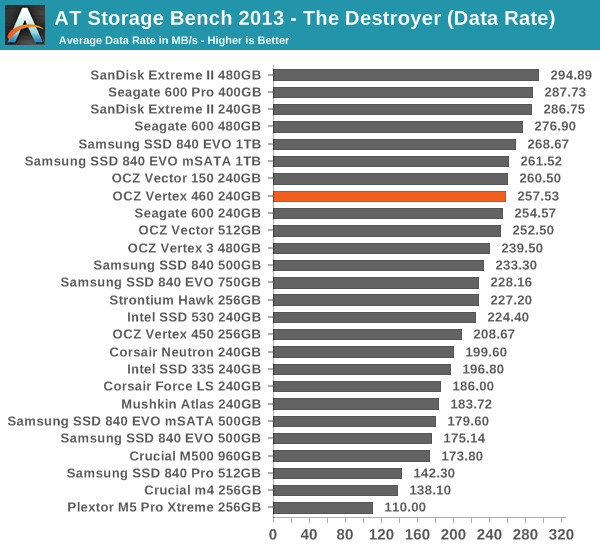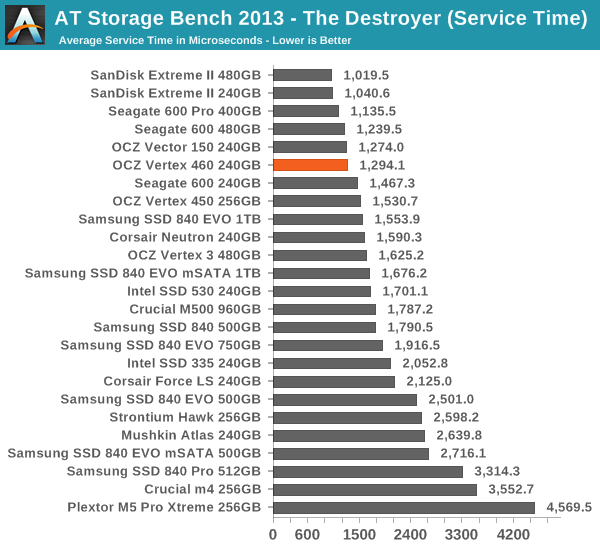OCZ Vertex 460 (240GB) Review
by Kristian Vättö on January 22, 2014 9:00 AM EST- Posted in
- Storage
- SSDs
- OCZ
- Indilinx
- Vertex 460
AnandTech Storage Bench 2013
When Anand built the AnandTech Heavy and Light Storage Bench suites in 2011 he did so because we did not have any good tools at the time that would begin to stress a drive's garbage collection routines. Once all blocks have a sufficient number of used pages, all further writes will inevitably trigger some sort of garbage collection/block recycling algorithm. Our Heavy 2011 test in particular was designed to do just this. By hitting the test SSD with a large enough and write intensive enough workload, we could ensure that some amount of GC would happen.
There were a couple of issues with our 2011 tests that we've been wanting to rectify however. First off, all of our 2011 tests were built using Windows 7 x64 pre-SP1, which meant there were potentially some 4K alignment issues that wouldn't exist had we built the trace on a system with SP1. This didn't really impact most SSDs but it proved to be a problem with some hard drives. Secondly, and more recently, we've shifted focus from simply triggering GC routines to really looking at worst-case scenario performance after prolonged random IO.
For years we'd felt the negative impacts of inconsistent IO performance with all SSDs, but until the S3700 showed up we didn't think to actually measure and visualize IO consistency. The problem with our IO consistency tests is that they are very focused on 4KB random writes at high queue depths and full LBA spans–not exactly a real world client usage model. The aspects of SSD architecture that those tests stress however are very important, and none of our existing tests were doing a good job of quantifying that.
We needed an updated heavy test, one that dealt with an even larger set of data and one that somehow incorporated IO consistency into its metrics. We think we have that test. The new benchmark doesn't even have a name, we've just been calling it The Destroyer (although AnandTech Storage Bench 2013 is likely a better fit for PR reasons).
Everything about this new test is bigger and better. The test platform moves to Windows 8 Pro x64. The workload is far more realistic. Just as before, this is an application trace based test–we record all IO requests made to a test system, then play them back on the drive we're measuring and run statistical analysis on the drive's responses.
Imitating most modern benchmarks Anand crafted the Destroyer out of a series of scenarios. For this benchmark we focused heavily on Photo editing, Gaming, Virtualization, General Productivity, Video Playback and Application Development. Rough descriptions of the various scenarios are in the table below:
| AnandTech Storage Bench 2013 Preview - The Destroyer | ||||||||||||
| Workload | Description | Applications Used | ||||||||||
| Photo Sync/Editing | Import images, edit, export | Adobe Photoshop CS6, Adobe Lightroom 4, Dropbox | ||||||||||
| Gaming | Download/install games, play games | Steam, Deus Ex, Skyrim, Starcraft 2, BioShock Infinite | ||||||||||
| Virtualization | Run/manage VM, use general apps inside VM | VirtualBox | ||||||||||
| General Productivity | Browse the web, manage local email, copy files, encrypt/decrypt files, backup system, download content, virus/malware scan | Chrome, IE10, Outlook, Windows 8, AxCrypt, uTorrent, AdAware | ||||||||||
| Video Playback | Copy and watch movies | Windows 8 | ||||||||||
| Application Development | Compile projects, check out code, download code samples | Visual Studio 2012 | ||||||||||
While some tasks remained independent, many were stitched together (e.g. system backups would take place while other scenarios were taking place). The overall stats give some justification to what we've been calling this test internally:
| AnandTech Storage Bench 2013 Preview - The Destroyer, Specs | |||||||||||||
| The Destroyer (2013) | Heavy 2011 | ||||||||||||
| Reads | 38.83 million | 2.17 million | |||||||||||
| Writes | 10.98 million | 1.78 million | |||||||||||
| Total IO Operations | 49.8 million | 3.99 million | |||||||||||
| Total GB Read | 1583.02 GB | 48.63 GB | |||||||||||
| Total GB Written | 875.62 GB | 106.32 GB | |||||||||||
| Average Queue Depth | ~5.5 | ~4.6 | |||||||||||
| Focus | Worst-case multitasking, IO consistency | Peak IO, basic GC routines | |||||||||||
SSDs have grown in their performance abilities over the years, so we wanted a new test that could really push high queue depths at times. The average queue depth is still realistic for a client workload, but the Destroyer has some very demanding peaks. When we first introduced the Heavy 2011 test, some drives would take multiple hours to complete it; today most high performance SSDs can finish the test in under 90 minutes. The Destroyer? So far the fastest we've seen it go is 10 hours. Most high performance SSDs we've tested seem to need around 12–13 hours per run, with mainstream drives taking closer to 24 hours. The read/write balance is also a lot more realistic than in the Heavy 2011 test. Back in 2011 we just needed something that had a ton of writes so we could start separating the good from the bad. Now that the drives have matured, we felt a test that was a bit more balanced would be a better idea.
Despite the balance recalibration, there is just a ton of data moving around in this test. Ultimately the sheer volume of data here and the fact that there's a good amount of random IO courtesy of all of the multitasking (e.g. background VM work, background photo exports/syncs, etc...) makes the Destroyer do a far better job of giving credit for performance consistency than the old Heavy 2011 test. Both tests are valid; they just stress/showcase different things. As the days of begging for better random IO performance and basic GC intelligence are over, we wanted a test that would give us a bit more of what we're interested in these days. As Anand mentioned in the S3700 review, having good worst-case IO performance and consistency matters just as much to client users as it does to enterprise users.
We are reporting two primary metrics with the Destroyer: average data rate in MB/s and average service time in microseconds. The former gives you an idea of the throughput of the drive during the time that it was running the Destroyer workload. This can be a very good indication of overall performance. What average data rate doesn't do a good job of is taking into account response time of very bursty (read: high queue depth) IO. By reporting average service time we heavily weigh latency for queued IOs. You'll note that this is a metric we've been reporting in our enterprise benchmarks for a while now. With the client tests maturing, the time was right for a little convergence.

The Vertex 460 is only a hair slower than the Vector 150 in our Storage Bench 2013. The difference actually falls into the margin of error, so it seems that in spite of the lower clock speed, the performance is essentially the same.











69 Comments
View All Comments
Kristian Vättö - Wednesday, January 22, 2014 - link
All OEMs do cherry-picking, so blaming OCZ is useless. However, in SSDs it doesn't matter that much because NAND is binned for endurance, not performance. While there can always be minor differences in performance between units, it's nowhere near as big as in e.g. CPUs.As for buying review samples, that would not be financially efficient. Consumer Reports and the like are different because they're funded by the government or other huge organisation, whereas we are private. Furthermore, we wouldn't be able to deliver reviews on time for release because we'd have to wait for retail availability like everyone else.
FunBunny2 - Wednesday, January 22, 2014 - link
I can 'buy' the second reason, but Anand can't afford a $300 SSD? Come on.bhaberle - Wednesday, January 22, 2014 - link
So you are telling me you would be okay with spending at minimum, tens of thousands of dollars on parts? Sure that is just ONE $300 SSD. What about about the other 15+ that they would need to get. Be realistic. If it is not a big deal, why don't you go buy that many. Sure they make money with this site, but it would take some time just to break even on the costs of the parts even for a large site like Anandtech. If you don't appreciate the effort they put in their reviews then stick to consumer reports.blanarahul - Wednesday, January 22, 2014 - link
That's what I said.BTW, can you guys test Samsung XP941?? And if possible, a comparison with 2 840 Pros in SLI.
Uhh. RAID..
Kristian Vättö - Friday, January 24, 2014 - link
I asked Samsung for a sample a while back but they wouldn't send us one since it's an OEM-only product. However, Anand got a pair of XP941s in the new Thunderbolt 2 equipped LaCie drive... ;-)henrybravo - Wednesday, January 22, 2014 - link
Great comment. Blame company PR, not Anandtech.PEJUman - Wednesday, January 22, 2014 - link
I own various branded SSDs, Intel, OCZ, Corsair to name a few.Some fails some don't (yes, even my intel X25-M G2 failed me at one point).
In the end, Anandtech readers are typically smart enough to run backups so any failures like that is not a big deal.
I form my own price/performance/risk assesment:
I use newegg, amazon, slickdeals, camelx3 for price.
Anandtech, Toms and forums for performance.
and lastly verified buyer comments at newegg & amazon for risk.
I could care less about a brand or what color is the box of my CPU/GPU.
MrSpadge - Wednesday, January 22, 2014 - link
And some people are obsessed with hating OCZ. Sure they made several mistakes, some not directly related to their technology. But that happened years ago. Sit back and see how the new drives developed in coorporation with Toshiba work out. Judge those drives by what they are, not what their grand-grandfathers were.Bob Todd - Wednesday, January 22, 2014 - link
You make it sound like all of their problems with quality control and high failure rates happened in the ancient past. This site's Vector review sample died during testing less than 3 months ago. I'm on my 3rd Agility 4 after RMAs and this one needs to go back too. That drive only came out ~18 months ago. I'd be happy to embrace a new wave of OCZ SSDs that were reliable, but we won't know how well (or if) they've managed to turn things around until we get several models in consumers hands and have adequate time to judge reliability.Roland00Address - Thursday, January 23, 2014 - link
OCZ has made plenty of shitty ssds in the last 3 years. I will be happy to buy a OCZ/Toshiba SSD but not until they have a track record of 3 good years for their ssds.Why deal with the head ache of your computer going out or your data corrupted just to save $10 or $20 dollars?